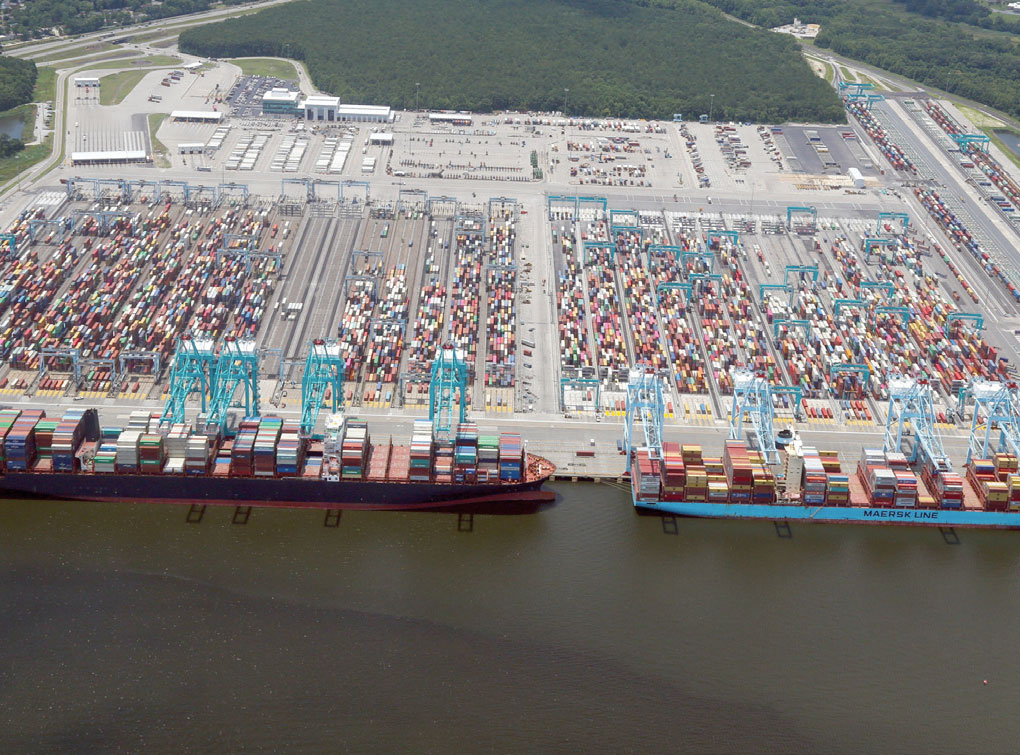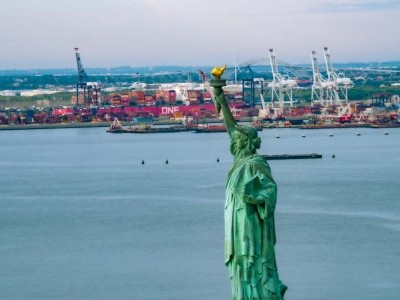Cargo Volumes Continue Slide in May; Trend Could Last Through August
Jun 15, 2020The Port of Virginia’s cargo volumes are continuing to reflect the impact of the COVID- 19 pandemic on commercial shipping as the port, in May, experienced its biggest one-month volume drop since the virus began slowing the global economy.
The amount of cargo moving across the port’s terminals in May declined by more than 59,000 TEUs (twenty- foot equivalent units) when compared with May 2019. The decline is reflected in almost every area of the operation: truck moves, rail volume, breakbulk tonnage and the amount of cargo being handled at Virginia Inland Port. The amount of cargo the port is moving by barge and volumes at Richmond Marine Terminal, however, grew, 3.4 percent and 24 percent, respectively.

“It is a significant loss in volume that is being felt throughout the organization and the situation is similar across the entire maritime industry,” said John F. Reinhart CEO and executive director of the Virginia Port Authority. “We are forecasting that this trend will continue through the end of summer because our customers are telling us that the blank sailings will continue into early September. The blank sailings were supposed to subside in early August, but the ocean carriers are telling us the volume just isn’t there yet. Our economy is reawakening and we are optimistic about the future, but the recovery is going to take time and patience.”
The spread of the virus is slowing and the port is maintaining the precautionary processes it has been using to keep colleagues and its labor partners safe. Use of masks, social distancing, workplace cleaning and working from home, when possible, continue.
“The Port of Virginia Team and our labor partner, the International Longshoremen’s Association, have been very fortunate and come through this largely healthy and intact,” Reinhart said. “It’s important to recognize their professionalism and thank them for their dedication.”
Despite the pandemic’s impact on cargo volume, progress on the expansion of NIT’s south-side container stack yard, the 55-foot channel project and Orsted’s offshore-wind project at Portsmouth Marine Terminal (PMT) continue.
In May, the final group of automated stacking cranes arrived at Norfolk International Terminals successfully ending just over two years of constant deliveries of the machines that are the centerpieces of the expansion at that terminal; NIT’s expansion will be complete this fall. The dredging project that will make Virginia home to the deepest port on the U.S. East Coast is running ahead of schedule and PMT is preparing for the arrival of Orsted in late 2020.
“Our focus is on building a modern, efficient port that serves as an economic engine for all of Virginia and provides long-term value for our customers and the cargo owners that choose The Port of Virginia,” Reinhart said.
In addition to focusing on recovery and expansion, the port is supporting the effort to confront the realities of the systemic racist practices and injustice that have been part of the daily lives of Black Americans. An important first step, Reinhart said, was participating last week with the ILA and industry peers from Maine to Texas in an hour of reflection on the tragic death of George Floyd.
“This effort is as important as anything we are doing right now,” Reinhart said. “We must show one another and our communities that we are steadfast in confronting the realities of our system and we are committed to our values and to each other. We stand in solidarity with the Black community in the fight against a centuries- old pattern of violence and suppression. There is a significant amount of work that lies ahead, but we cannot be deterred by that. Open, honest, and compassionate dialogue with each other and the willingness to listen and learn are the beginnings of positive change.”
May Cargo Snapshot
- Total TEUs – 201, 837, down, 22. 6%
- Loaded Export TEUs – 72, 160, down 18. 1%
- Loaded Import TEUs – 87, 669 down, 26. 7%
- Total Containers – 112, 913, down, 22. 7%
- Virginia Inland Port Containers – 2, 117, down 24. 7%
- Total Rail Containers – 37,205, down 27.4%
- Total Truck Containers – 71,117, down 21.3%
- Total Barge Containers – 4,591, up 3.4%
- Richmond Marine Terminal Containers – 3,413, up 24%
Similar Stories

Strike updates on Canada’s West Coast and Port of Montreal
View ArticlePorts awarded more than half a billion in MARAD PIDP Grants
The $580 million in grants awarded today range in size from more than $53 million for the Port of San Juan Puerto Rico to restore key wharves to $708,750 for…
View Article
Port of Hamburg: Sustained growth in hinterland transports
View Article
Port of Hueneme and Port of Paita sign MoU to establish a sister port relationship
View Article
New electric yard truck helps Port of Tacoma demonstrate zero-emission technology
View Article
Port Authority of NYNJ proposes $9.4 billion budget for 2025
View ArticleGet the most up-to-date trending news!
SubscribeIndustry updates and weekly newsletter direct to your inbox!





